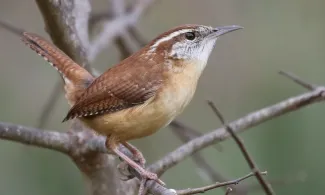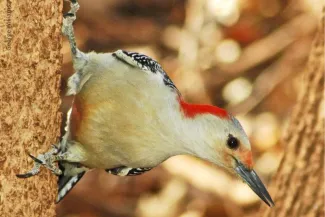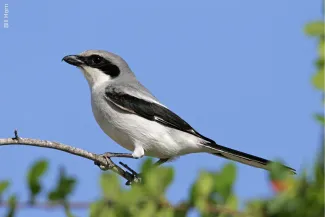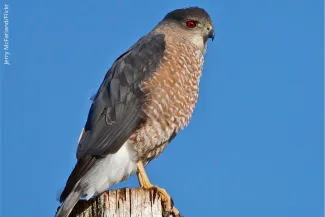Waiting. It’s a familiar word for deer hunters. On average, Oklahoma’s hunters spend 16 days in the field waiting for the right deer. But they may have to wait only a few minutes for the birds to resume their hustle and bustle.
Six Birds to Watch this Hunting Season:
Tufted Titmouse

A regular in wooded areas, the tufted titmouse is a great source of tree stand entertainment. These active and acrobatic birds are almost constantly on the move, searching for insects and seeds on tree branches and wildflower stalks. They often move about in pairs or in small flocks with other woodland birds, especially Carolina chickadees, brown creepers and nuthatches.
Tufted titmice have a gray and white body, a small black bill, prominent crest and buffy pink sides. Their song is a loudly whistled “peter, peter, peter.”
Carolina Wren

With a bullhorn for a bill, the Carolina wren is an exceptionally loud visitor to wooded stands or blinds. Wrens often feed near the ground, riffling through leaf litter for spiders or insects or looking for berries or seeds in thick brush.
Carolina wrens have a distinctive white eyebrow, reddish-brown back and head and a softer cinnamon colored belly. Their tail is finely barred and is almost always up-turned. Their song is a recurring “teacher, teacher, teacher;” these wrens have a number of shorter calls.
Red-bellied Woodpecker

A rolling laugh often announces the red-bellied woodpecker before it swoops into view. These birds frequent sturdy tree trunks, “chucking” as they search the tree bark for insects.
Relatively large woodpeckers, red-bellied woodpeckers have a black and white hashed back and a bright red head. They’re named for the rarely seen red tinge on their belly.
Loggerhead Shrike

Often called the “butcher bird,” the loggerhead shrike typically hunts from a perch, watching the surrounding grasslands for small rodents or lizards. After a successful hunt, these predatory songbirds hang their victims to dry on a thorn or nearby barbed-wire fence.
Though half the size of a mockingbird, loggerhead shrikes are similar in appearance to the more common backyard songster. They have a gray body with black and white wings and a prominent black mask.
Sharp-shinned Hawk

Tree stand hunters are occasionally buzzed by fast moving raptors, especially sharp-shinned hawks, while waiting for official shooting hours. These acrobats move through the forest with impressive speed, darting through the tangled tree limbs.
Sharped-shinned hawks, often referred to as “sharpies”, have a rust and white barred front and a blue tinted back and head. Juveniles are brown with a brown and white mottled chest. Adults have red eyes. These small raptors are similar in size to an American kestrel.
Northern Harrier

While many hunters will be posted in a stand or blind, northern harriers will be showing off their stalking skills as they float over thickets and brambles in search of small birds or rodents.
Harriers are fairly large raptors, with long wings and tail. Females are dark brown above and tan underneath while males are gray above and white underneath with dark wing patches. Both males and females have a distinctive white rump patch.